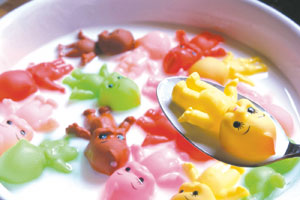Confession time: I was not one of those boys who secretly loved dolls. There was that pre-pubescent naughtiness imposed on a de-accessorized GI Joe and my neighbor’s sister’s Barbie, sure; but beyond that, nothing.
So why, then, am I so enamored of Lisa Shenouda’s kewpie-doll photo series Subtle Bodies, which is beginning an extended run at downtown’s Gold Hill Espresso & Fine Teas?
It’s not as simple for me as their appalling cuteness. Nor even their culture over-familiarity.
The true kewpie doll can be traced to 1909, to the first illustrations of cupid-styled babies (thus, “kewpie”) that accompanied Rose O’Neil children’s poems in The Ladies Home Journal. Soon after, the big-bellied, ridge-headed babies (often sporting tiny wings) pervaded the culture. Unglazed ceramic versions were huge sellers in the 1910s, and by the ’30s, lower-quality kewpies were popular giveaways at carnivals and festivals.
“Everybody, I think, had a kewpie doll as a kid,” muses Asheville resident Lori Mullett, recently admiring the Subtle Bodies exhibit. (I don’t share my GI Joe story with her).
Shenouda’s doll subjects, mostly bought in 1998 at the Tokio 7 consignment store in New York City (for $1 apiece), are mass-produced, inch-and-a-half Japanese knockoffs of the classic kewpie.
“The ones that I have are kind of a new breed,” Shenouda jokes over a pot of tea at Pyper’s Place on Montford Avenue.
And regardless of their overall color — pink, brown, yellow, green — the wingless, plastic, ever-smiling figures all have one distinctly Western trait. As illustration, Shenouda holds out two dolls of differing hues.
“What’s the one thing they have in common,” she asks, “other than their height?”
It’s important to her that people get this (Shenouda includes this detail even in her artist’s statement): The diminutive dolls’ eyes are blue.
“Japanese people don’t have blue eyes,” she elaborates. “So who is it reflecting — their culture, or their ideal culture? Or maybe [it’s that] they just had extra blue ink.”
Cultural conundrums, ironies and disparities — the artist has a weakness for them.
“I’m a culture-theory junkie,” she admits.
Shenouda, 26, of Egyptian descent, hails from Chattanooga, Tenn. She attended Cornell University in Ithaca, N.Y., where she began seriously indulging her fascination with film, and her passion for cultural critique (a la Marshall McLuhan, Jean Baudrillard, Paul Virilio).
During a two-year leave of absence from Cornell to live in New York City, Shenouda took some design classes and generally went nuts with her camera.
“I burned a lot of film that first year in New York,” she reveals. “Many, many portraits of people in their natural context.” (She hopes to convert some of this work, plus travel shots from Egypt, into future shows.)
It was a design-class assignment while in the Big Apple — to create a CD cover — that formally launched her kewpie vision. (Ironically, Shenouda’s richly surreal “lucid dream no. 24,” which isn’t part of her current show, is slated as the cover of local band DrugMoney’s upcoming debut album, MTN CTY JNK.)
The culture of culture
The poses and themes in Shenouda’s work are often strikingly familiar. Iconic, even.
In “you have to see it to believe it,” a flesh-colored kewpie is perched atop a rock, the Grand Canyon falling off behind it. Wish you were here!
Cereal days |
 |
|
“luxurious milk bath”, by Lisa Shenouda |
In “luxurious milk bath,” a variety of kewpies float belly-up in a bowl of milk — remember that alphabet cereal you loved as a kid? — beneath a raised spoon bearing a single yellow doll. And “bath” is vaguely disconcerting, as if we’re consuming, somehow, ourselves.
Some of Shenouda’s work can be, in fact, downright sinister. Subversive, even.
“[The kewpies’] innocent demeanor combined with their underlying creepiness was just what I wanted to grab people visually,” Shenouda wrote in a recent e-mail. “To roughly quote … David McConville — “to punch them in the gut while shooting them in the head.”
Some photos are easily read: “nuclear family,” with its two altered kewpies (one missing an arm, the other with its head on backwards); and “we didn’t know it was loaded,” with its huddle of smiling dolls in the foreground, and the prone, out-of-focus shape in the grass behind them.
However, much of her work’s seeming universality is often the direct result of some TV or glossy-mag advertising assault that’s gotten under Shenouda’s skin. For instance, the charming “sublime sublimation” — two front-lit kewpies standing in the high grass, with the foreground doll slightly out of focus — was in part inspired by a Tommy Hilfiger ad campaign.
“I love creating images,” Shenouda writes. “But even more so … I get a huge thrill creating images about images.
“I would like these [photos] to somehow tap into the collective unconsciousness of anybody who grew up with any form of visual media — TV, magazines, postcards, family albums, etc.”
All dolled up
Subtle Bodies is now in its third local showing (the kewpies actually debuted at Cornell): In June, it hung briefly at the now-defunct Ion Gallery, next moving to Kismet Cafe in Biltmore Village. The current, nine-photo Gold Hill exhibit runs through Sept. 30.



Before you comment
The comments section is here to provide a platform for civil dialogue on the issues we face together as a local community. Xpress is committed to offering this platform for all voices, but when the tone of the discussion gets nasty or strays off topic, we believe many people choose not to participate. Xpress editors are determined to moderate comments to ensure a constructive interchange is maintained. All comments judged not to be in keeping with the spirit of civil discourse will be removed and repeat violators will be banned. See here for our terms of service. Thank you for being part of this effort to promote respectful discussion.